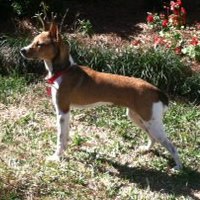 |
| Pugh's Sissy (daughter of Gray's Prairie Daisy) is going STRONG in Virginia. |
We've been busy working pups and keeping the more seasoned squirrel dogs in shape. Many happy hunters of Gray's Mountain Feist are sending in reports. Most pictures sent in to us may be viewed on our Facebook page: https://www.facebook.com/grayfeist
Also, don't forget to follow us on Twitter @GrayFeist
I have been in discussions with a man who films hunts for TV about going on some hunts with us and our dogs. The plan is to start filming after Thanksgiving. More details to follow!
We have no pups right now but there are some pups out of our stock available in Virginia. Shoot us an e-mail at graysfeist@gmail.com and I'll point you in the right direction. Our next litter will be in 2014.
Gray's John Colter (below) is at a new home in Maryland. He and his new owner, Corey Moorer are getting acquainted, making some trees and having a good ol' time. We look forward to Corey's updates as the season progresses.
This week we are scheduled to begin a major overhaul of the Gray's Mountain Feist website. New pictures, info and a whole lot more! The site has now had in excess of 28,000 hits and we appreciate everyone's interest & support.
Also, don't forget to stop by our discussion forum to talk dogs. Registration is free and the site is easy to use. Ask questions, see updates and talk about hunting. http://graysfeist.proboards.com/
Jess took 1/2 of her Hunter Education course last night so look for her to be featured in more hunt videos/pictures.
 |
| Whitmire's Dolly is another 5th generation Gray's Mountain Feist gettin' the job done down in Tennessee. |
HAPPY HUNTING!!!
-Marc & Jess Gray
Happiness is a Gray Bred Mountain Feist










